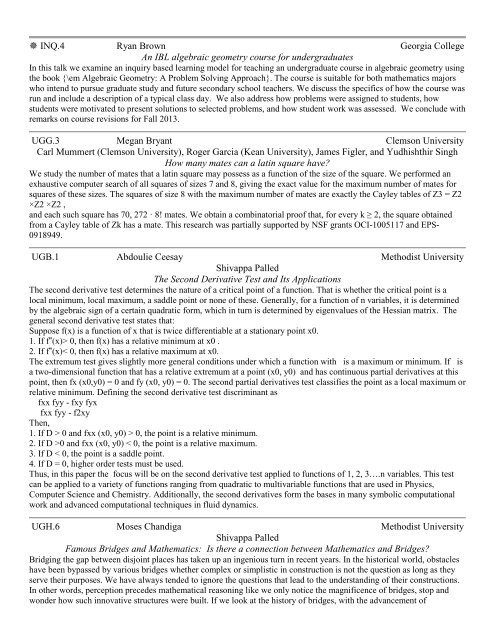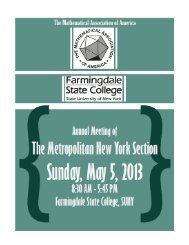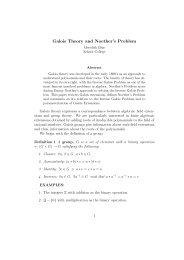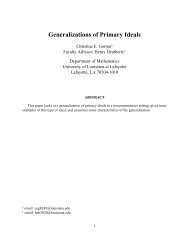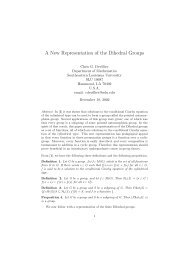Presentation Abstracts - MAA Sections
Presentation Abstracts - MAA Sections
Presentation Abstracts - MAA Sections
Create successful ePaper yourself
Turn your PDF publications into a flip-book with our unique Google optimized e-Paper software.
INQ.4 Ryan Brown Georgia College<br />
An IBL algebraic geometry course for undergraduates<br />
In this talk we examine an inquiry based learning model for teaching an undergraduate course in algebraic geometry using<br />
the book {\em Algebraic Geometry: A Problem Solving Approach}. The course is suitable for both mathematics majors<br />
who intend to pursue graduate study and future secondary school teachers. We discuss the specifics of how the course was<br />
run and include a description of a typical class day. We also address how problems were assigned to students, how<br />
students were motivated to present solutions to selected problems, and how student work was assessed. We conclude with<br />
remarks on course revisions for Fall 2013.<br />
UGG.3 Megan Bryant Clemson University<br />
Carl Mummert (Clemson University), Roger Garcia (Kean University), James Figler, and Yudhishthir Singh<br />
How many mates can a latin square have?<br />
We study the number of mates that a latin square may possess as a function of the size of the square. We performed an<br />
exhaustive computer search of all squares of sizes 7 and 8, giving the exact value for the maximum number of mates for<br />
squares of these sizes. The squares of size 8 with the maximum number of mates are exactly the Cayley tables of Z3 = Z2<br />
×Z2 ×Z2 ,<br />
and each such square has 70, 272 · 8! mates. We obtain a combinatorial proof that, for every k ≥ 2, the square obtained<br />
from a Cayley table of Zk has a mate. This research was partially supported by NSF grants OCI-1005117 and EPS-<br />
0918949.<br />
UGB.1 Abdoulie Ceesay Methodist University<br />
Shivappa Palled<br />
The Second Derivative Test and Its Applications<br />
The second derivative test determines the nature of a critical point of a function. That is whether the critical point is a<br />
local minimum, local maximum, a saddle point or none of these. Generally, for a function of n variables, it is determined<br />
by the algebraic sign of a certain quadratic form, which in turn is determined by eigenvalues of the Hessian matrix. The<br />
general second derivative test states that:<br />
Suppose f(x) is a function of x that is twice differentiable at a stationary point x0.<br />
1. If f”(x)> 0, then f(x) has a relative minimum at x0 .<br />
2. If f”(x)< 0, then f(x) has a relative maximum at x0.<br />
The extremum test gives slightly more general conditions under which a function with is a maximum or minimum. If is<br />
a two-dimensional function that has a relative extremum at a point (x0, y0) and has continuous partial derivatives at this<br />
point, then fx (x0,y0) = 0 and fy (x0, y0) = 0. The second partial derivatives test classifies the point as a local maximum or<br />
relative minimum. Defining the second derivative test discriminant as<br />
fxx fyy - fxy fyx<br />
fxx fyy - f2xy<br />
Then,<br />
1. If D > 0 and fxx (x0, y0) > 0, the point is a relative minimum.<br />
2. If D >0 and fxx (x0, y0) < 0, the point is a relative maximum.<br />
3. If D < 0, the point is a saddle point.<br />
4. If D = 0, higher order tests must be used.<br />
Thus, in this paper the focus will be on the second derivative test applied to functions of 1, 2, 3….n variables. This test<br />
can be applied to a variety of functions ranging from quadratic to multivariable functions that are used in Physics,<br />
Computer Science and Chemistry. Additionally, the second derivatives form the bases in many symbolic computational<br />
work and advanced computational techniques in fluid dynamics.<br />
UGH.6 Moses Chandiga Methodist University<br />
Shivappa Palled<br />
Famous Bridges and Mathematics: Is there a connection between Mathematics and Bridges?<br />
Bridging the gap between disjoint places has taken up an ingenious turn in recent years. In the historical world, obstacles<br />
have been bypassed by various bridges whether complex or simplistic in construction is not the question as long as they<br />
serve their purposes. We have always tended to ignore the questions that lead to the understanding of their constructions.<br />
In other words, perception precedes mathematical reasoning like we only notice the magnificence of bridges, stop and<br />
wonder how such innovative structures were built. If we look at the history of bridges, with the advancement of


